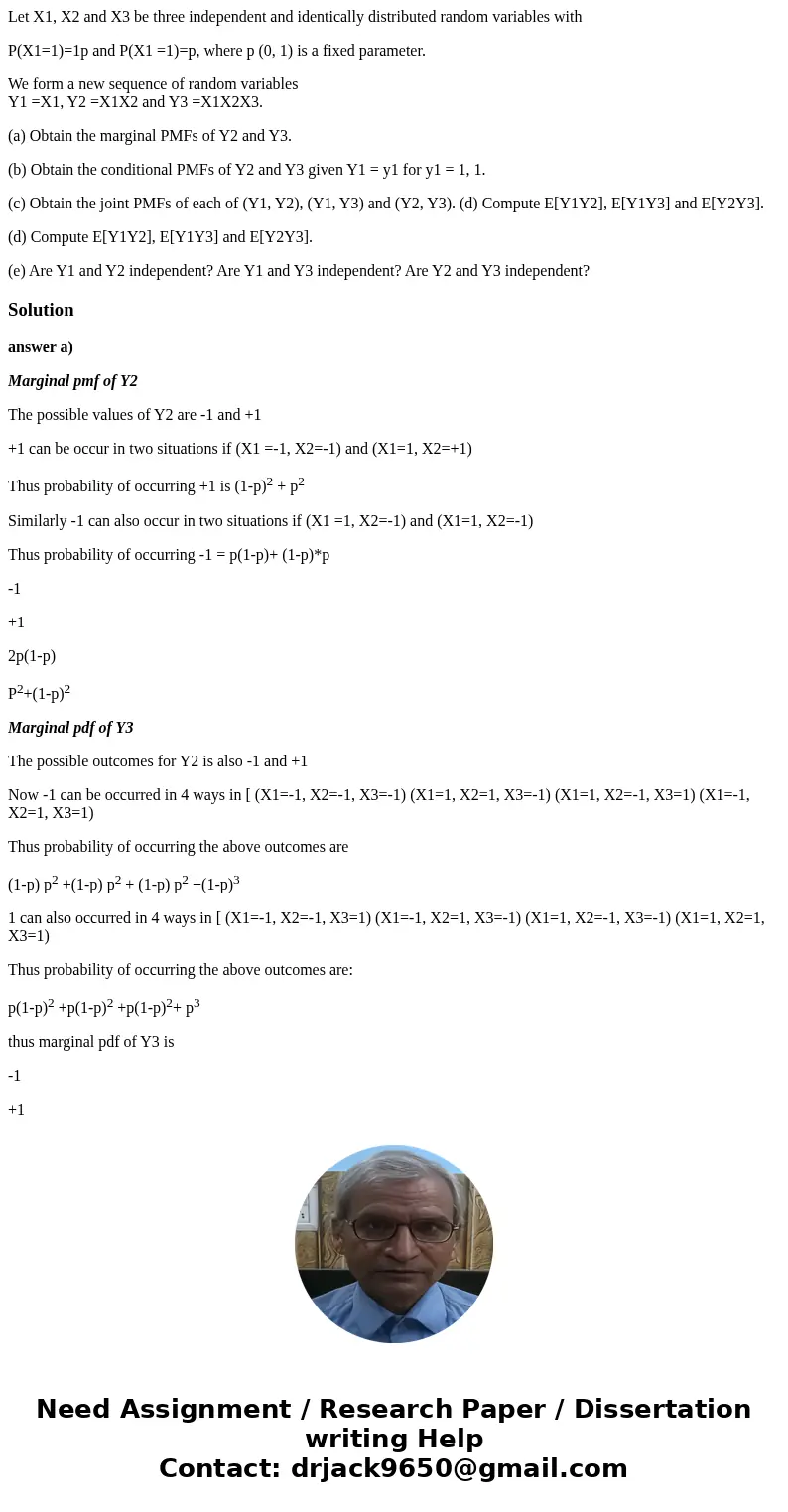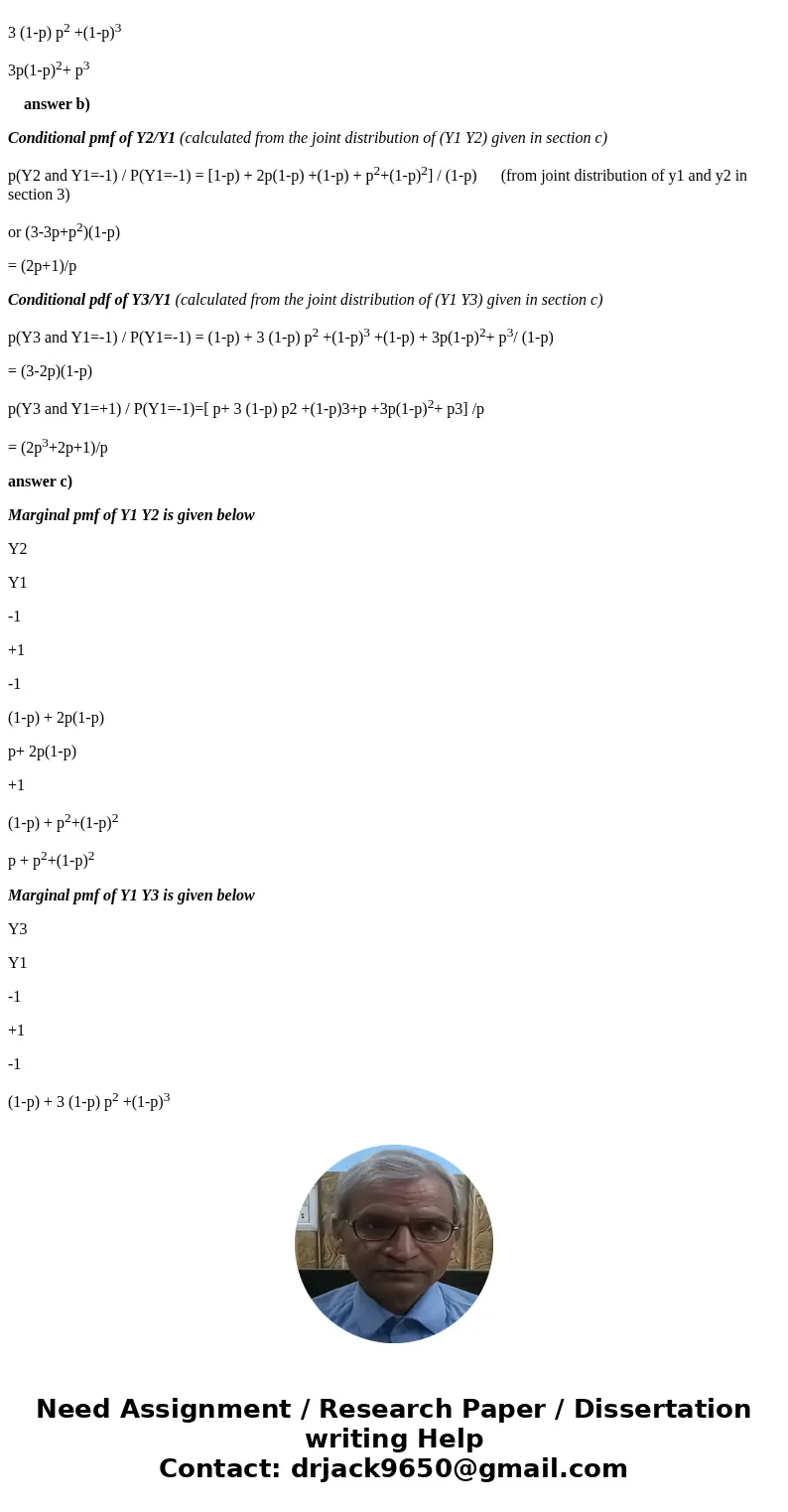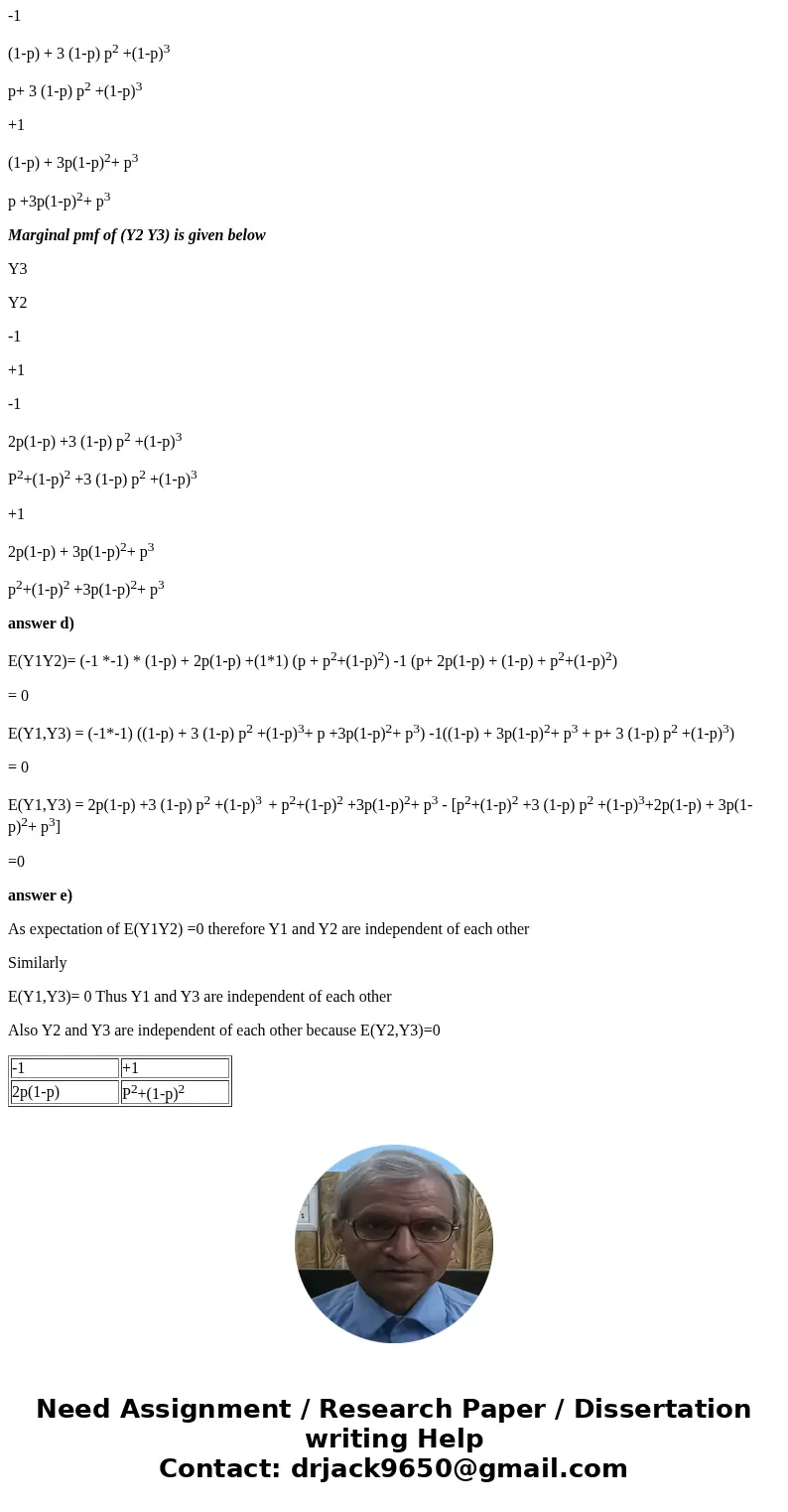Let X1 X2 and X3 be three independent and identically distri
Let X1, X2 and X3 be three independent and identically distributed random variables with
P(X1=1)=1p and P(X1 =1)=p, where p (0, 1) is a fixed parameter.
We form a new sequence of random variables
Y1 =X1, Y2 =X1X2 and Y3 =X1X2X3.
(a) Obtain the marginal PMFs of Y2 and Y3.
(b) Obtain the conditional PMFs of Y2 and Y3 given Y1 = y1 for y1 = 1, 1.
(c) Obtain the joint PMFs of each of (Y1, Y2), (Y1, Y3) and (Y2, Y3). (d) Compute E[Y1Y2], E[Y1Y3] and E[Y2Y3].
(d) Compute E[Y1Y2], E[Y1Y3] and E[Y2Y3].
(e) Are Y1 and Y2 independent? Are Y1 and Y3 independent? Are Y2 and Y3 independent?
Solution
answer a)
Marginal pmf of Y2
The possible values of Y2 are -1 and +1
+1 can be occur in two situations if (X1 =-1, X2=-1) and (X1=1, X2=+1)
Thus probability of occurring +1 is (1-p)2 + p2
Similarly -1 can also occur in two situations if (X1 =1, X2=-1) and (X1=1, X2=-1)
Thus probability of occurring -1 = p(1-p)+ (1-p)*p
-1
+1
2p(1-p)
P2+(1-p)2
Marginal pdf of Y3
The possible outcomes for Y2 is also -1 and +1
Now -1 can be occurred in 4 ways in [ (X1=-1, X2=-1, X3=-1) (X1=1, X2=1, X3=-1) (X1=1, X2=-1, X3=1) (X1=-1, X2=1, X3=1)
Thus probability of occurring the above outcomes are
(1-p) p2 +(1-p) p2 + (1-p) p2 +(1-p)3
1 can also occurred in 4 ways in [ (X1=-1, X2=-1, X3=1) (X1=-1, X2=1, X3=-1) (X1=1, X2=-1, X3=-1) (X1=1, X2=1, X3=1)
Thus probability of occurring the above outcomes are:
p(1-p)2 +p(1-p)2 +p(1-p)2+ p3
thus marginal pdf of Y3 is
-1
+1
3 (1-p) p2 +(1-p)3
3p(1-p)2+ p3
answer b)
Conditional pmf of Y2/Y1 (calculated from the joint distribution of (Y1 Y2) given in section c)
p(Y2 and Y1=-1) / P(Y1=-1) = [1-p) + 2p(1-p) +(1-p) + p2+(1-p)2] / (1-p) (from joint distribution of y1 and y2 in section 3)
or (3-3p+p2)(1-p)
= (2p+1)/p
Conditional pdf of Y3/Y1 (calculated from the joint distribution of (Y1 Y3) given in section c)
p(Y3 and Y1=-1) / P(Y1=-1) = (1-p) + 3 (1-p) p2 +(1-p)3 +(1-p) + 3p(1-p)2+ p3/ (1-p)
= (3-2p)(1-p)
p(Y3 and Y1=+1) / P(Y1=-1)=[ p+ 3 (1-p) p2 +(1-p)3+p +3p(1-p)2+ p3] /p
= (2p3+2p+1)/p
answer c)
Marginal pmf of Y1 Y2 is given below
Y2
Y1
-1
+1
-1
(1-p) + 2p(1-p)
p+ 2p(1-p)
+1
(1-p) + p2+(1-p)2
p + p2+(1-p)2
Marginal pmf of Y1 Y3 is given below
Y3
Y1
-1
+1
-1
(1-p) + 3 (1-p) p2 +(1-p)3
p+ 3 (1-p) p2 +(1-p)3
+1
(1-p) + 3p(1-p)2+ p3
p +3p(1-p)2+ p3
Marginal pmf of (Y2 Y3) is given below
Y3
Y2
-1
+1
-1
2p(1-p) +3 (1-p) p2 +(1-p)3
P2+(1-p)2 +3 (1-p) p2 +(1-p)3
+1
2p(1-p) + 3p(1-p)2+ p3
p2+(1-p)2 +3p(1-p)2+ p3
answer d)
E(Y1Y2)= (-1 *-1) * (1-p) + 2p(1-p) +(1*1) (p + p2+(1-p)2) -1 (p+ 2p(1-p) + (1-p) + p2+(1-p)2)
= 0
E(Y1,Y3) = (-1*-1) ((1-p) + 3 (1-p) p2 +(1-p)3+ p +3p(1-p)2+ p3) -1((1-p) + 3p(1-p)2+ p3 + p+ 3 (1-p) p2 +(1-p)3)
= 0
E(Y1,Y3) = 2p(1-p) +3 (1-p) p2 +(1-p)3 + p2+(1-p)2 +3p(1-p)2+ p3 - [p2+(1-p)2 +3 (1-p) p2 +(1-p)3+2p(1-p) + 3p(1-p)2+ p3]
=0
answer e)
As expectation of E(Y1Y2) =0 therefore Y1 and Y2 are independent of each other
Similarly
E(Y1,Y3)= 0 Thus Y1 and Y3 are independent of each other
Also Y2 and Y3 are independent of each other because E(Y2,Y3)=0
| -1 | +1 |
| 2p(1-p) | P2+(1-p)2 |



 Homework Sourse
Homework Sourse